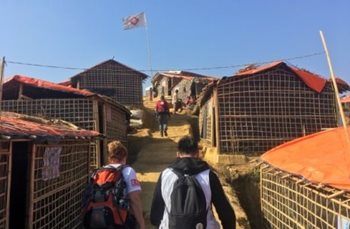By Jason Creaghan, Canadian aid worker in Bangladesh
By 9 a.m., fog has burned off and I am already looking for shade as we begin the hour-long walk through the makeshift settlement in Kutupalong. We are headed to the Bangladesh Red Crescent Society mobile clinic. After many trips, we know the trail reasonably well, only occasionally needing the local volunteers to guide us through new market areas or construction sites, which seem to appear

everyday along the route. We are from different worlds - Bangladesh, Myanmar and Canada - yet we chat easily about the work day to come. What was chaotic and overwhelming a few weeks ago has become familiar – it is easy to forget that this great sprawling village is one of the largest camps of displaced people in the world.
Six months ago, violence in the Rakhine state of Myanmar forced an estimated 688,000 people to flee into Bangladesh, where they have settled in several areas south of the city of Cox’s Bazar. The Canadian Red Cross has sent a small team, supported by the Government of Canada, to work with the Bangladesh Red Crescent Society to establish a mobile health clinic in a remote part of Kutupalong, the largest settlement. I am part of the last rotation of Canadian aid workers in the
Emergency Response Unit, tasked with handing over the clinic operations to local staff and volunteers with the Bangladesh Red Crescent.
We arrive at the clinic and set up a triage area, stools for consultations and a basic pharmacy. Dr. Sajib will do most of the consultations today. Ms. Nasima, the midwife, will see pregnant women and provide safe-home-birth-kits. The small bamboo and tin roof structure soon fills with mothers and babies. It is hot and dusty and chaotic. We see children with respiratory infections, diarrhoea, dehydration, intestinal parasites, and injuries. A young woman has fever and throat pain. I put a paper mask over her face and arrange for her to be escorted to the nearby diphtheria treatment centre. We have basic medications only and although we can refer very ill patients to the Red Cross field hospital where we are based, for many patients with more chronic issues we have no response. My translator, Raj, laughs at me as I try to greet the patients in their language. I hope respect is therapeutic because that is often all I have to offer.
The clinic is located on a hilltop in what was once a nature reserve, which my guide book says was a refuge for the last remaining wild elephants of Bangladesh. Now the forest is gone, and as I take a water break outside, I can see to the northwest horizon that the hills are covered with the bamboo and tarp structures which are home to some of the 15,000 people in our designated area. Flags of the organizations that provide services to this area dot the hills and provide us with landmarks. Further west into the reserve, what were barren hills a few days ago are now terraced and sandbagged. Crews of camp residents are converting piles of bamboo into woven mats, which they wrap around larger bamboo frames and roof with tarp so rapidly that a neighbourhood can appear out of the dust in a day or two.
We see the last patients and clean up by mid-afternoon, and begin the walk back to the Base Camp. Later tonight I will sit and drink tea in the hospital yard looking out towards the hills of Myanmar, and listen to the hospital staff review the events of the day.
The trail home follows a muddy river that winds through the camp. This area has been settled for several months, and colleagues who were here in the beginning tell us that the shock and fear they saw among the residents initially is gone for the most part. Markets spread along the busiest pathways, gardens sprout on any unclaimed patch of land, and tarp huts are turning into more solid bamboo structures. When the rains start in a few weeks, many of the low areas will be flooded, diarrheal diseases will almost certainly increase and there will be more displacement and challenges. But as we move through the bustle of the camp at the end of day, the scene is of resilience rather than despair. Boys fly kites made from discarded plastic bags. They call to us as we pass, “How are you? I am fine!” and laugh when they get a response. They walk with us for a while until we approach the busy road that defines the edge of the camp then return to their play in the way of children everywhere.